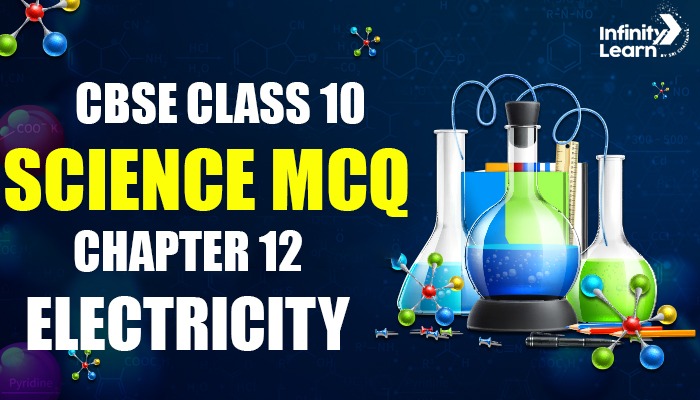Table of Contents
MCQ on Electricity Class 10: Master the concepts of electricity with our comprehensive CBSE Class 10 Science Chapter 12 MCQs. This chapter, “Electricity,” covers the basics of electric current, circuits, and electrical power. We designed set of MCQ questions with answers to help students easily understand these electrical concepts. Our collection of CBSE Class 10 MCQs includes a wide range of topics, from Ohm’s law to how electrical appliances work. Each question follows the CBSE syllabus, ensuring you are well-prepared for exams. Improve your understanding and performance with our Class 10 Science MCQs, created to make learning enjoyable.
Additionally, you can download NCERT solutions for Class 10 Science to aid in your comprehensive understanding and revision.

Science Chapter 12 MCQ On Electricity Class 10
Q1. Which of the following is the unit of electric current?
a) Volt
b) Ohm
c) Ampere
d) Watt
Answer: c) Ampere
Q2. Ohm’s Law states that the current flowing through a conductor between two points is directly proportional to the:
a) Power
b) Voltage
c) Resistance
d) Energy
Answer: b) Voltage
Q3. What is the formula for calculating electric power?
a) Power = Voltage x Resistance
b) Power = Voltage / Current
c) Power = Current x Resistance
d) Power = Voltage x Current
Answer: d) Power = Voltage x Current
Q4. In a series circuit, the total resistance is:
a) Equal to the resistance of the smallest resistor
b) Equal to the sum of the resistances
c) Equal to the resistance of the largest resistor
d) Equal to the product of the resistances
Answer: b) Equal to the sum of the resistances
Q5. If a 60-watt bulb operates on a 120-volt supply, the current flowing through the bulb is:
a) 0.5 A
b) 2 A
c) 1.5 A
d) 0.75 A
Answer: a) 0.5 A
Q6. Which of the following materials is a good conductor of electricity?
a) Rubber
b) Plastic
c) Wood
d) Copper
Answer: d) Copper
Q7. What happens to the resistance of a conductor if its length is doubled, keeping the cross-sectional area the same?
a) The resistance is halved
b) The resistance remains the same
c) The resistance is doubled
d) The resistance is tripled
Answer: c) The resistance is doubled
Q8. In a parallel circuit, the total resistance:
a) Is greater than the smallest resistance
b) Is equal to the sum of all resistances
c) Is smaller than the smallest resistance
d) Is equal to the product of all resistances
Answer: c) Is smaller than the smallest resistance
Q9. Which instrument is used to measure electric current in a circuit?
a) Voltmeter
b) Ammeter
c) Ohmmeter
d) Galvanometer
Answer: b) Ammeter
Q10. What is the effect of increasing the cross-sectional area of a conductor on its resistance?
a) Resistance increases
b) Resistance decreases
c) Resistance remains unchanged
d) Resistance becomes zero
Answer: b) Resistance decreases
Don’t Miss:
- NCERT Solutions of Chapter 12 Electricity
- Electricity Class 10 Notes Chapter 12
- NCERT Exemplar Solutions for Class 10 Science Chapter 12
- Electric Current Formulas
Science Chapter 12 MCQ On Electricity Class 10 (Moderate to High Level)
Q1. A wire of resistance 10 ohms is stretched to double its original length. What will be the new resistance?
a) 10 ohms
b) 20 ohms
c) 40 ohms
d) 5 ohms
Answer: c) 40 ohms
Q2. Two resistors of 6 ohms and 12 ohms are connected in parallel. What is the equivalent resistance of the combination?
a) 18 ohms
b) 4 ohms
c) 8 ohms
d) 3 ohms
Answer: b) 4 ohms
Q3. If 5 coulombs of charge flow through a conductor in 2 seconds, what is the current flowing through the conductor?
a) 10 A
b) 0.4 A
c) 2.5 A
d) 5 A
Answer: c) 2.5 A
Q4. A 100 W, 200 V bulb is connected to a 100 V supply. What will be the power consumed by the bulb?
a) 25 W
b) 50 W
c) 75 W
d) 100 W
Answer: a) 25 W
Q5. Three resistors of 2 ohms, 3 ohms, and 6 ohms are connected in series. What is the potential difference across the 3 ohm resistor if the total voltage is 11 V?
a) 2 V
b) 3 V
c) 4 V
d) 5 V
Answer: b) 3 V
Q6. The resistance of a 10-meter long wire is 5 ohms. What will be the resistance of a 20-meter long wire of the same material and thickness?
a) 2.5 ohms
b) 5 ohms
c) 10 ohms
d) 20 ohms
Answer: c) 10 ohms
Q7. A battery of 12 V is connected to a resistor of 4 ohms. What is the current flowing through the resistor?
a) 3 A
b) 6 A
c) 0.33 A
d) 48 A
Answer: a) 3 A





